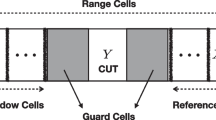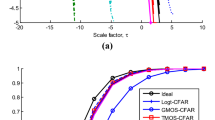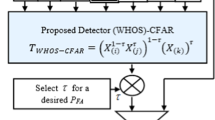Abstract
The present study considers detection of the weak Swerling targets which exist in the clutter Doppler cell of the Weibull-distributed ground-based clutter by means of Independent Component Analysis (ICA). We present a new detector based on convolutive ICA that is independent of target and clutter statistical distribution and has no need to the previous knowledge of the radar signals. For the detection of radar target using ICA, there are some problems that are solved by two wisely proposed approach through the detector. Synthetic generated clutter and target are used to show quantitatively and qualitatively the capability of the proposed ICA-based detector. Also, the method is tested against real-life data. Finally, the computational time is considered and the superiority of the detector is shown by a comparison between the proposed and a typical Neyman-Pearson (NP) detector.






Similar content being viewed by others
REFERENCES
M. Greco, F. Bordoni, and F. Gini, “X-band sea-clutter nonstationarity: Influence of long waves,” IEEE J. Ocean. Eng. 29, 269–283 (2004).
R. Vicen-Bueno, M. Rosa-Zurera, M. P. Jarabo-Amores, and R. Gil-Pita, “Automatic target detection in simulated ground clutter (Weibull distributed) by multilayer perceptrons in a low-resolution coherent radar,” IET Radar, Sonar Navig. 4, 315–328 (2010).
A. Farina, F. Gini, M. V. Greco, and L. Verrazzani, “High resolution sea clutter data: statistical analysis of recorded live data,” IEE Proceedings-Radar, Sonar Navig. 144, 121–130 (1997).
S. Haykin, Adaptive Radar Signal Processing (Wiley, Hoboken, New Jersey, 2007).
Modern Radar Detection Theory, Ed. by De Maio and Greco, (IET, 2015).
Y.-L. Shi and P.-L. Shui, “Target detection in high-resolution sea clutter via block-adaptive clutter suppression,” IET Radar, Sonar Navig. 5, 48–57 (2011).
Y. Xiang, D. Peng, and Z. Yang, Blind Source Separation (Springer Singapore, Singapore, 2015).
A. Cichocki and S.-I. Amari, Adaptive Blind Signal and Image Processing (Chichester, Wiley, 2002).
S. Makino, T.-W. Lee, and H. Sawada, Blind Speech Separation (Springer-Verlag, 2007).
H. Ghahramani, M. Barari, & Mohammad, H. Bastani, and M. H. Bastani, “Maritime radar target detection in presence of strong sea clutter based on blind source separation,” IETE J. Res. 60, 331–344 (2014).
H. Ghahramani, M. Barari, and M. H. Bastani, “Suppressing sea clutter in maritime radar based on DUET BSS,” J. Iran. Assoc. Electr. Electron. Eng. 12 (2015).
A. Hyvärinen, J. Karhunen, and E. Oja, Independent Component Analysis (Wiley, New York, 2001).
A. Mansour, A. K. Barros, and N. Ohnishi, “Blind separation of sources: Methods, assumptions and applications,” IEICE Trans. Fundam. Electron. Commun. Comput. Sci. 83, 1498–1512 (2000).
M. W. Long, Radar Reflectivity of Land and Sea (Artech House Books, 1983).
S. C. Douglas, M. Gupta, H. Sawada, and S. Makino, “Spatio-temporal fast ICA algorithms for the blind separation of convolutive mixtures,” IEEE Trans. Audio, Speech, Lang. Processing 15, 1511–1520 (2007).
A. Hyvärinen and E. Oja, “Independent component analysis: algorithms and applications,” Neural Networks 13, 411–430 (2000).
M. I. Skolnik, Introduction to Radar Systems (Artech House, Norwood, MA, 2005).
M. A. Richards, Fundamental of Radar Signal Processing, 2nd Ed., (McGraw-Hill, 2014).
M. A. Richards, J. A. Scheer, and W. A. Holm, Principles of Modern Radar, Vol. I: Basic Principles (SciTech Pub, 2010).
Y. Xiang, D. Peng, and Z. Yang, Blind Source Separation: Dependent Component Analysis (Springer-Verlag, 2015).
P. Comon, “Independent component analysis, a new concept,” Signal Process. 36, 287–314 (1994).
P. P. Vaidyanathan, Multirate Systems and Filter Banks (Prentice Hall, 1993).
L. Gang and K. Yu, “Modelling and simulation of coherent Weibull clutter,” IEE Proc. F (Radar Signal Process.) 136, 2–12 (1989).
I. Pobocikova and Z. Sedliackova, “Comparison of four methods for estimating the Weibull distribution parameters,” Appl. Math. Sci. 8, 4137–4149 (2014).
P. Ramírez and J. A. Carta, “Influence of the data sampling interval in the estimation of the parameters of the Weibull wind speed probability density distribution: a case study,” Energy Convers. Manag. 46, 2419–2438 (2005).
R. Vicen-bueno, M. Rosa-zurera, S. Member, M. P. Jarabo-amores, and D. De Mata-moya, “Coherent Detection of Swerling 0 Targets in Sea-Ice Weibull-Distributed Clutter Using Neural Networks,” IEEE Trans. Instrum. Meas. 59, 3139–3151 (2010).
Author information
Authors and Affiliations
Corresponding author
Rights and permissions
About this article
Cite this article
Ghahramani, H., Parhizgar, N., Arand, B.A. et al. Ground (Weibull-Distributed) Clutter Suppression Based on Independent Component Analysis for Detection of Swerling Target Models. J. Commun. Technol. Electron. 65, 160–171 (2020). https://doi.org/10.1134/S1064226920020072
Received:
Revised:
Accepted:
Published:
Issue Date:
DOI: https://doi.org/10.1134/S1064226920020072




